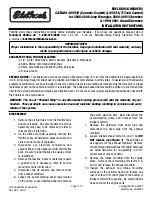
Brakes and Breakaway Systems
Ver-Mac 2018
PCMS Operations, Safety & Maintenance V3.0
19
7.1.1
Testing the Brakes
NOTE
Testing the trailer braking system is always a two person operation.
Testing Procedure
1.
Deploy the jacks and raise wheels off the ground
2.
Check the condition of the wiring, electrical connectors (especially the main trailer
connector), magnets and battery. Make sure the emergency battery in the battery
box is fully charged (12.6V)
3.
Pull on the emergency breakaway cable while your partner vigorously spins the
trailer wheel, to see if it stops the wheels
4.
If the brakes fail to apply, check wiring continuity, the trailer circuit breaker or fuse,
ground connections and magnets
7.1.2
Maintenance
CAUTION
Do not get grease or oil on the brake linings, drums or magnets
(electric system)
.
Full Maintenance Procedure
1. Inspect all wiring (secure, attached in position)
2. Check connection plugs at the tow vehicle end and at the trailer end for corrosion.
Spray with penetrating fluid or WD-40
3. If electrical system is not working properly, check the electrical ground
4. Remove the brake drums and clean inside the brakes. Check magnets, brake pads,
shoes and related components. Replace as necessary
5. Pack wheel bearings with grease before the drum is installed
6. Adjust and test the brakes
7. Test drive the trailer behind a vehicle to confirm that brakes function
7.2
Hydraulic Surge Brakes
NOTE
This component is an option on Ver-Mac PCMS. Please check that your PCMS
has this component
before
proceeding.
In a hydraulic surge brake system, an actuator responds to the braking signal from the
tow vehicle and activates the trailer brakes. The braking process is automatic.
If separation of trailer and tow vehicle occurs, the breakaway cable pulls tight and
triggers the actuator to apply the trailer brakes.
NOTE
When you replace components in the hydraulic braking system, or if there is a
leak, you also have to bleed the brakes.
















































